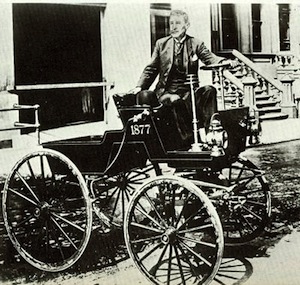
Selden on his Motor Wagon
"George Baldwin Selden, Inventor of the gasoline automobile", is what his tombstone says and the facts suggest that his epitaph is true. George Selden's name is rarely found in automobile historical books but he led the charge for the development of the gasoline powered horseless carriage - in a rather dubious manner.
Selden was born in 1846, served in the American Civil War and studied engineering before becoming a United States patent attorney. The engineering came from a keen interest in improving how things were being made and the law degree was an attempt to appease his father, and they both served him well. He used his engineering skills to improve on an engine design and his legal knowledge to take advantage of the United States patent system.
Selden was raised to love horses but during the war he was given a mean, unmanageable steed and by the war's end he was dreaming of a horseless carriage. His vision was a small vehicle that could be operated by one person and go long distances at a time when no such thing existed anywhere in the world. At that time, the late 1860s, steam power was the dominate form of man-made horsepower and a roadworthy gasoline engine was still 25 years away. The first gasoline engines came in 1872 when the American George Brayton and German Nikolaus Otto introduced their totally different internal combustion engines. And when Selden saw the Brayton engine at the Centennial Exposition in Philadelphia four years later he went to work on improving the design.

Selden Patent Plate
While the Otto engine was based on the same four-stroke design we use today, the Brayton engine had separate cylinders for intake, compression and combustion and supplied the gasoline vapor at a constant pressure. Both designs showed promise but both were also too big and heavy to be used in a vehicle. However by 1879 Selden had succeeded in building a one-horsepower Brayton engine that weighed only 400 pounds, one fourth of the original, by reducing the piston size and stroke and enclosing the crankcase.
Selden knew two important things about patent law at the time. First, he knew he could only collect royalties for 17 years, at which time anybody could copy his work. Second, and most importantly, he knew that patents could be amended within two years of their application and changes would restart the two-year clock. That meant that he could submit modifications every two years and thereby keep his patent pending an unlimited amount of time, which he did for 16 years. And that allowed him to be first with the application while delaying the start of the 17-year clock until 1895, when there was an abundance of automobile manufacturers from which to collect royalties.
His plan worked. In 1877 he submitted plans for a final prototype and in 1879 he was granted a very broad United States patent that gave him the rights to all gasoline powered automobiles that could be considered commercially practical. The patent caused such a furor among the hundreds of automobile manufactures that several lawsuits followed but no one was able to break his stronghold. As a result, most of the manufacturers united to create the Association of Licensed Vehicle Manufacturers (ALVM) as a body to oversee royalty payments and assure that those who did not pay their fair share were, along with their customers, properly threatened and challenged in court. Meanwhile in 1885 Karl Benz became the first person to actually build a practical gasoline powered automobile (the Benz Patent Motorwagen), using an Otto cycle engine.
Membership in ALVM became a requirement for receiving the rights to use the Selden patent and when Henry Ford's application was denied on dubious grounds, since members of the board were among his competitors, he became irate. Ford, and other disgruntled manufacturers, responded by building vehicles without the patent rights and in 1903 the ALVM won a law suit to stop them, to which Ford filed an appeal. Ford's argument was that the ALVM had no right to sanction him because he was using the Otto engine rather than the Brayton and the patent was therefor irrelevant. The battle lasted for nine years, until in 1911, when a court of appeals agreed with Ford. And since most everyone was also using the Otto engine the ALVM was soon disbanded. When George Selden was asked how he felt about the verdict he replied, "I went into this enterprise hoping to make a little money out of it. I have succeeded much better than I expected and as my patent has but a year or two to run, the decision has no severe significance." George Selden opened the Selden Motor Vehicle Company in 1906 and produced about 1,000 vehicles a year through 1913. They then switched to trucks in 1915 and the company was sold to the Bethlehem Truck Company in 1930. George B. Selden died in 1922.



